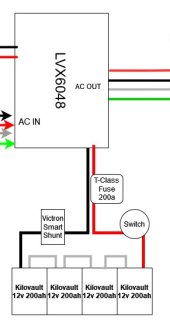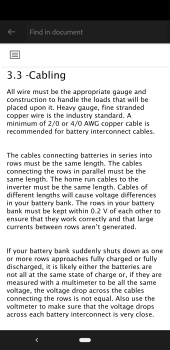kevolones
New Member
- Joined
- Nov 13, 2021
- Messages
- 52
Regarding equal length battery to Inverter cables:
How should I go about this when I "interrupt" the cable's length with a Shunt Monitor (at negative) and Fuse+Switch (on positive)?
I understand the reason behind having same length wire is due to the resistance of the wires, but Im not sure if anything needs to be done to take in consideration the extra terminal lugs required for the shunt, switch and fuses and also if the devices themselves add any resistance/voltage drop. Are those negligible?
In that case, just sum up the wires length on the positive side and make sure its equal to the sum of the wires on the negative side?

Thanks in advance!!!
How should I go about this when I "interrupt" the cable's length with a Shunt Monitor (at negative) and Fuse+Switch (on positive)?
I understand the reason behind having same length wire is due to the resistance of the wires, but Im not sure if anything needs to be done to take in consideration the extra terminal lugs required for the shunt, switch and fuses and also if the devices themselves add any resistance/voltage drop. Are those negligible?
In that case, just sum up the wires length on the positive side and make sure its equal to the sum of the wires on the negative side?

Thanks in advance!!!



